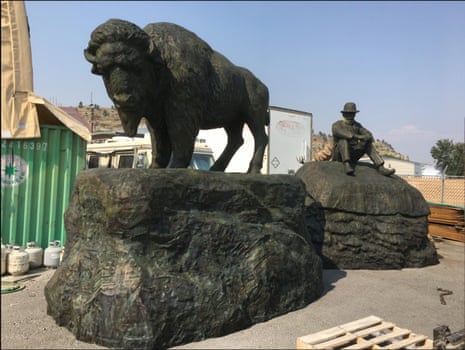A Canadian city has pulled a public art project over fears that a pair of towering bronze statues could be seen as an endorsement of colonialism – the exact opposite of the work’s intended meaning, according to the artist.
The work, which cost C$375,000 (US$285,000), comprises two large bronze figures which were intended to stand on either end of a pedestrian bridge in Edmonton. On one end, a 13ft bison was to stare out over the water. At the other, a colonial fur trader, measuring 11.5ft, would sit atop a pile of bison pelts.
But 12 years after they were first commissioned – and six years after they were completed, the capital of Alberta announced last week it was shelving plans to display the sculptures.
“While some audiences may find the artwork thought-provoking, for others it may cause harm and induce painful memories. For this reason, it is not considered inclusive to all Edmontonians,” the city said in a news release.
The artist responsible for the sculptures, Ken Lum, said that after waiting for years to see his statues unveiled, he had been blindsided by the decision.
“This has implications, both for artistic expression and the authoritarian way this decision is being made. You can never have total consensus about anything. Is that sufficient to deny a work to be published or work to go up into public space?”
Lum, chair of the department of fine arts at the University of Pennsylvania Stuart Weitzman School of Design, said the sculpture of the trader was based on a famous photograph depicting a similar scene that was taken not long before the collapse of the bison population.
In the mid-to-late 1800s, the plains bison, a once-plentiful food staple for Indigenous communities, were hunted to near extinction by colonial settlers. The hunt was driven both by profit and the broader political end of subjugating Indigenous communities.
“For people crossing the bridge, I wanted them to experience a palpable tension through the uneasy gaze from one to another,” Lum said.
“I don’t really see how a picture based on an infamous photograph, taken at the height of the buffalo slaughter, could be interpreted as an affirmation of colonialism. Neither the city nor the Arts Council has explained this to me. That would be nice and courteous of them. I’m all ears,” Lum said.
A spokesperson for the city cited a better understanding of the “historical injustices on Indigenous peoples” as factoring into the decision, which came as Canada continues to wrestle with the dark legacy of colonialism.
Lum, who is part of Monument Lab, a US-based non-profit that studies how history is told in the public landscape, said he met with Indigenous elders throughout the process and consulted with communities.
But Lewis Cardinal, a member of the Wicihitowin Talking Circle which advised the city of Edmonton and Edmonton Arts Council, said the bison was not a fitting symbol of the region’s past. Cardinal said that beaver pelts – not bison – had been the principal driver of the region’s economy.
“If you’re going to have Indigenous consultations, you have to actually listen,” he told CTV News.
The Indigenous groups signed off on the project, but Lum saw shortcomings in the consultations.
“No amount of listening too much on my part, will ever compensate for the centuries of not being listened to,” he said.
Of the questions he received about the work, a handful were why an Indigenous artist hadn’t been commissioned. Lum pointed out the requirement for the commission required a background in engineering and infrastructure, which narrowed the pool of candidates.
The city’s position has sparked a bigger conversation about public art, history and meaning. While Edmonton has pulled the plug on Lum’s work, a statue of Winston Churchill is set to be erected in the city of Calgary.
“Anything placed in public space is going to have a range of responses, based on literacy, and so many other factors,” said Lum. “But I believe that art should be challenging. And that challenge includes the demand on the public to actually invest in trying to interpret the work and invest in trying to read the work.
“It’s a shame [the city] chose to frame it a certain way, because I think the dialogue that would have ensued by my work would have been quite useful and productive for all.”
